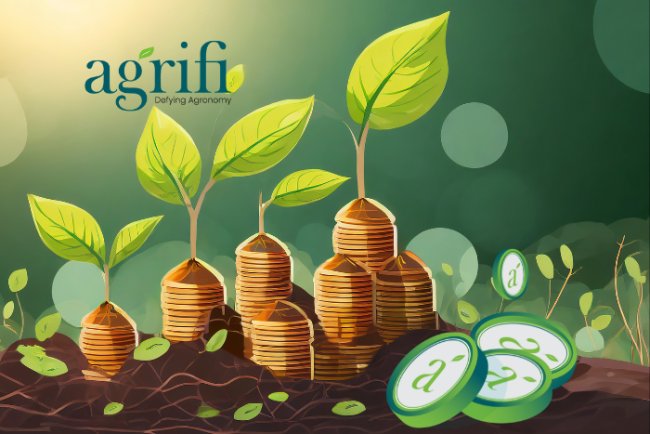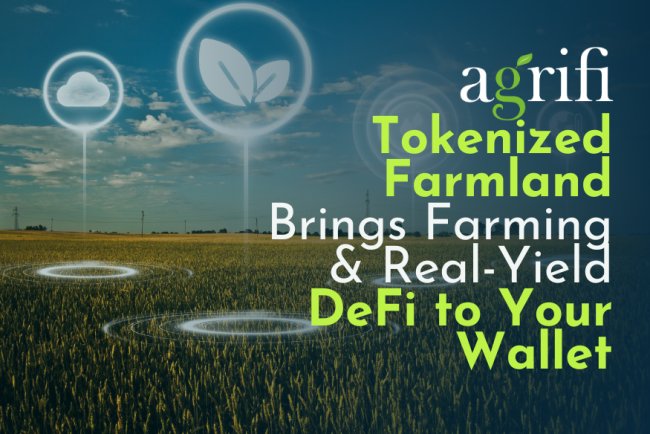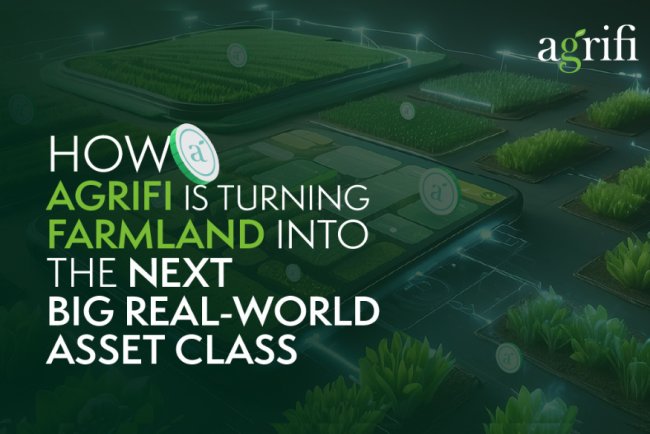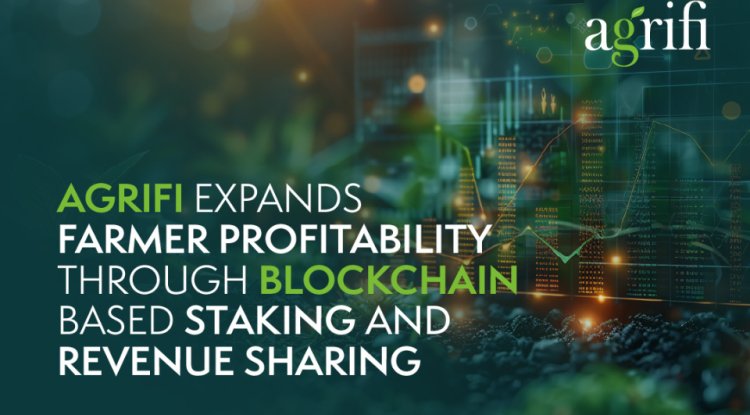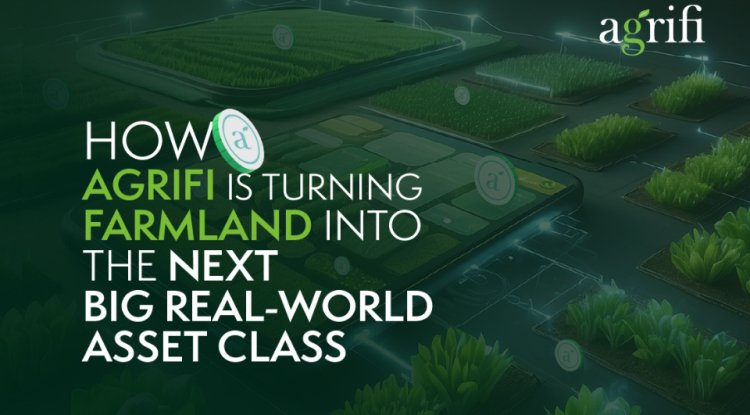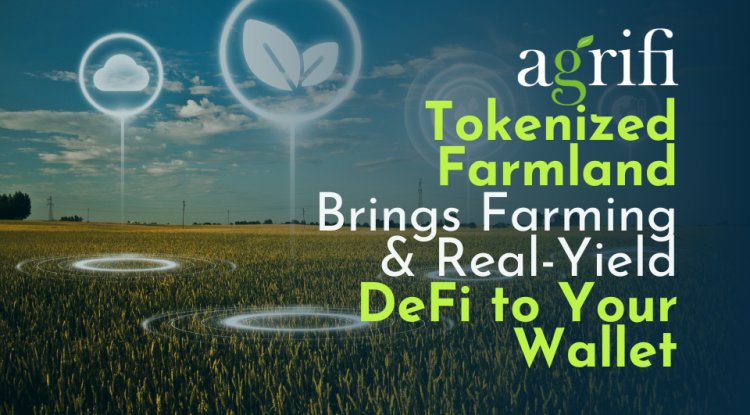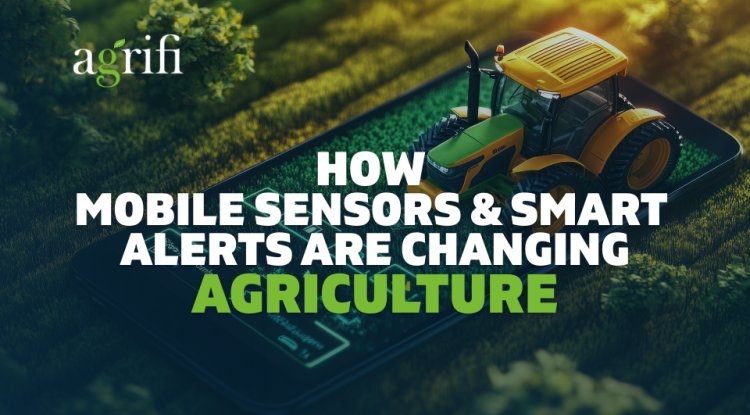AgriFi’s Blockchain & AI Ecosystem Redefines Agriculture Finance
Explore AgriFi’s layer blockchain ecosystem, where AI, IoT, and tokenized farmland create real-world utility, yield-driven DeFi, and global food security.

Estonia,15th September; AgriFi, a decentralized platform merging agriculture with blockchain, AI, and IoT, has officially unveiled its comprehensive 7-layer system architecture, a modular and scalable blueprint designed to bring real-world utility to decentralized finance (DeFi). At the core of this innovation is the AGF Token, a digital asset backed by tokenized farmland and real agricultural productivity.
In an era where speculation-driven tokens dominate the crypto landscape, AgriFi stands out by anchoring digital finance in the soil; enabling verifiable, productive, and sustainable value creation through agriculture.
"The future of DeFi isn't synthetic, it's rooted. At AgriFi, we're turning data into food, and farmland into yield-bearing assets that everyone can access," said Veronica Trump, CMO of AgriFi.
A New Blueprint for Global Agriculture Finance
The agricultural industry, valued at $12 trillion globally, has remained largely untransformed by the innovations seen in other industries. AgriFi is fundamentally changing that by introducing an AGF token-powered economy and technical architecture that empowers farmers and investors alike.
"We are not just building another agricultural app or simple blockchain token," said Veronica Trump, CMO at AgriFi. "We are creating a complete technology ecosystem that connects soil sensors in rural farms to investment portfolios in global financial centers. Every layer serves a critical function in transforming how agriculture operates and how the world invests in food production."
Unlike inflationary DeFi tokens, AGF staking rewards are generated from real-world crop performance. With yields ranging from 5% to 18% APY across multiple staking durations, AGF delivers a sustainable income model aligned with agricultural cycles.
Whether you're a farmer in Asia, an investor in Europe, or a stakeholder in global food systems, AgriFi enables active participation through a decentralized yet unified infrastructure.
But how does it actually work? Let's examine the technical infrastructure that's enabling farmers in rural areas to access global capital markets and allowing investors worldwide to own fractions of farmland through their smartphones.
Agrifi Technology Stack
Layer 1: Blockchain Infrastructure Foundation
The trust layer.Making Agricultural Investment Universal
At the foundation lies AgriFi's blockchain infrastructure powered by Polygon Network, chosen for its ability to process thousands of agricultural transactions daily at minimal cost. This base layer ensures every farming decision, crop yield, and investment transaction is permanently recorded and globally accessible.
Why This Matters: Unlike traditional agricultural records that can be lost, manipulated, or are inaccessible across borders, blockchain creates an immutable foundation of truth for the entire global agricultural system.
Key Components:
- Polygon Network: Lightning-fast, eco-friendly blockchain processing
- High throughput & scalability for global agricultural operations
- Low transaction costs for micro-investments and rural connectivity
- Ethereum compatibility to tap into established DeFi tools
- Validator network & performance metrics to ensure decentralization and speed
- Interoperability to integrate with diverse protocols and ecosystems
This base layer digitizes trust, enabling transparent ownership of farmland, secure transactions, and real-world yield recording.
AgriFi's choice of Polygon Network as its blockchain foundation isn't accidental, it's strategic. Agricultural operations require thousands of daily transactions: staking rewards, profit distributions, IoT data recording, and farmland ownership transfers. Ethereum's high gas fees would make these micro-transactions economically impossible.
Layer 2: Smart Contract Protocol Layer Automated Agricultural Finance
The automation layer. From crop insurance to investment distributions, everything happens automatically when predefined conditions are met.
Revolutionary Impact: A farmer experiencing drought can receive insurance payouts within hours instead of months, while investors automatically receive their share of harvest profits without any manual processing.
Core Protocols:
- AGF Token Core: The backbone of the ecosystem, enabling staking, governance, and rewards.
- Farmland Tokenization: Convert acres into fractionalized, tradable on-chain assets.
- AgriFi Staking System: Stake AGF tokens and earn passive income yield tied to crop performance.
- AgriFi Governance DAO: Token holders shape platform development and ESG policies.
These smart contracts are open-source, audited, and built for both scalability and security.
Staking System: Earning from Agricultural Productivity
Layer 3: AI & Machine Learning Engine Transforming Agricultural Data into Actionable Intelligence
The intelligence layer. Transforms farming from guesswork into precision science.
Game-Changing Capability: The AI can predict with remarkable accuracy whether a specific farm will be profitable next year, enabling smarter investment decisions and better farming practices.
AI-Powered Modules analyze, predict, and optimize agriculture in real-time:
- AgriFi Yield Intelligence: Predicts harvest output based on weather, soil, and seed data.
- AgriFi Risk Engine: Assesses climate, market, and operational risks in real-time
- Farm-to-Market AI: Aligns planting with real-time demand and pricing trends.
- AgriFi Decision Matrix: Recommends optimal farming actions across regions and crops.
This layer enables predictive finance, transforming yield forecasts into investment insights.
Layer 4: IoT Data Collection Network The Agricultural Nervous System
The sensing layer.
Thousands of connected sensors across global farmlands create an unprecedented real-time view of agricultural conditions. This layer transforms invisible farming processes into transparent, measurable data.
Breakthrough Innovation: For the first time, investors can monitor soil moisture, crop health, and weather conditions of their agricultural investments in real-time from anywhere in the world.
Comprehensive Monitoring A live stream of farm data is captured via:
- AgriFi Soil Network: Real-time soil health and nutrient monitoring
- AgriFi Weather Grid: Hyperlocal weather data and climate prediction
- AgriFi Drone Fleet: Aerial crop surveillance and health assessment
- AgriFi Satellite Data: Large-scale agricultural monitoring from space
- Farm Equipment IoT: Operational data from tractors, irrigation systems, Machinery performance and maintenance optimization
- AgriFi Supply Chain: Track input usage, harvest timing, and delivery logistics. The End-to-end logistics tracking
Every sensor becomes a yield oracle, turning farms into data-driven finance engines.
Layer 5: Data Management & Analytics Platform Agricultural Intelligence Hub
The processing layer.
This layer processes and stores the massive amounts of data generated by global agricultural operations, creating actionable insights that benefit both farmers and investors.
Unprecedented Transparency: Every stage of food production becomes visible and verifiable, from seed planting to final sale, creating trust and efficiency throughout the agricultural supply chain.
This backbone translates raw farm data into actionable intelligence:
- Blockchain Database: Tamper-proof records of crop output and asset ownership.
- IPFS Storage: Decentralized file storage for documents, certifications, and compliance.
- Real-time Analytics: Live Dashboards for farmers, investors, and ecosystem partners.
- Historical Data Indexing: Train AI models and conduct performance analysis. From ESG audits to staking returns, data powers every decision.
Layer 6: Security & Compliance Framework
Critical Protection: Agricultural investments often involve cross-border transactions and sensitive farming data, requiring enterprise-grade security that protects both financial assets and agricultural intellectual property.
The safeguard layer.
- Authentication & Biometric Access: Role-based, secure login for all stakeholders.
- Encryption & Privacy: End-to-end encryption across apps and nodes.
- Regulatory Compliance: GDPR, agri-export norms, and crypto KYC integration.
- Smart Insurance: Smart contracts tied to climate data provide instant crop coverage.
This layer builds global trust; ensuring compliance, transparency, and resilience.
Layer 7: User Interface & Experience Layer
The access layer.
The top layer makes sophisticated agricultural blockchain technology accessible to everyone from smallholder farmers in developing countries to institutional investors in major financial centers.
AgriFi prioritizes global usability with:
- AgriFi Web Dashboard: Portfolio, staking, farm data, and governance tools.
- AgriFi Mobile App: On-the-go insights for farmers and investors.
- AgriFi API Gateway: For third-party DeFi, AgriTech, and ESG platforms.
- Multilingual UI: Accessible across regions and literacy levels.
This layer democratizes DeFi, ensuring that real farmers and global investors can use the same platform with ease.
"This isn't just technological innovationit's an urgent response to global food security challenges," explained John Dembla, CTO. "Each layer of our architecture addresses specific barriers that have prevented agriculture from accessing the capital and technology it needs to feed the world."
Industry Transformation Implications
The comprehensive nature of AgriFi's 7-layer architecture positions it to transform multiple aspects of the agricultural industry:
Agricultural Finance: Streamlining lending, insurance, and investment processes Supply Chain Management: Providing end-to-end visibility and optimization Risk Management: Enabling predictive analytics and automated responses Global Trade: Facilitating cross-border agricultural transactions Sustainable Farming: Incentivizing environmentally beneficial practices
About AgriFi
Agrifi is driving an agricultural revolution, harnessing blockchain technology to transform the agricultural supply chain. Our mission is to enhance transparency, efficiency, and sustainability in agriculture while empowering farmers and supporting small-scale agricultural practices.
Join us on this exciting journey to explore the future of agriculture while potentially enhancing the value of your AGF tokens. We’re not just redefining agricultural finance; we’re revolutionizing the future of farming and food production.
Ready to start staking your AGF tokens? Visit our website at https://agrifi.app/auth for detailed steps on how to stake your tokens. Stay connected with us on Telegram, Twitter, Facebook and Instagram for the latest updates and community discussions.
Follow Us on:
Telegram: https://t.me/agrifi_official
Facebook: https://www.facebook.com/agrifiofficial
Instagram: https://www.instagram.com/agrifi_official/
Twitter: https://x.com/Agrifi_official
Website: https://agrifi.tech/
FAQ
Q1: What is AGF Token?
AGF is the native token of the Agrifi platform, offering fractional farmland ownership, crop-backed staking rewards, and governance participation.
Q2. Where can I buy AGF Tokens?
AGF is currently available on LBank and Bitbulls centralized exchanges. You can also buy AGF directly through Agrifi’s official DEX platform at https://dex.agrifi.app using a Polygon-compatible wallet like MetaMask.
Q3. What do I need to start?
You’ll need a Web3 wallet such as MetaMask.
- To swap via dex.agrifi.app, connect your MetaMask wallet and trade using USDT or MATIC.
- To buy via exchanges like LBank or Bitbulls, you can transfer USDT from your existing exchange (e.g., Binance) and trade for AGF.
Q4. What is the minimum investment amount?
The minimum investment typically starts from just $10, depending on the exchange’s trading rules.
Q5. Is AGF considered a Real-World Asset (RWA)?
Yes. AGF represents fractional ownership of farmland and its corresponding crop output, making it a blockchain-powered Real-World Asset with measurable economic and environmental value.
Q6: Is AGF Token secure?
Yes. It runs on the Polygon blockchain with smart contracts managing staking, governance, and agri-data integration.
Q7: What makes AGF different from other DeFi tokens?
Unlike many tokens, AGF is anchored to real agricultural output, providing tangible yield and ESG benefits.
Q8. Is AGF available globally?
Yes. As a Polygon-based asset, it is accessible via most Web3 wallets and DeFi platforms globally.

What's Your Reaction?







